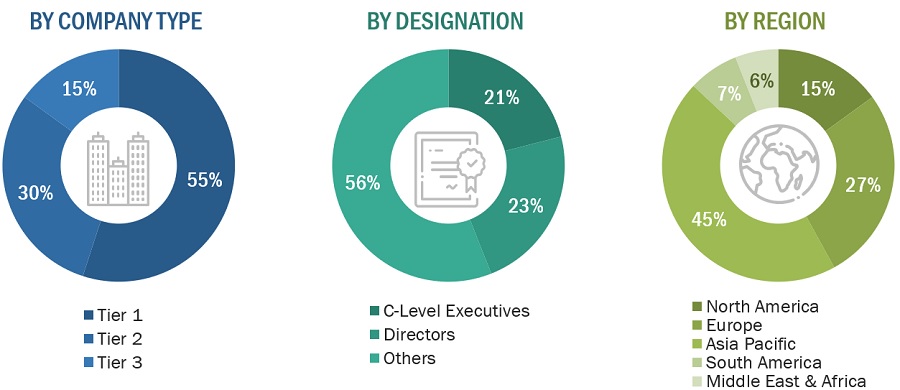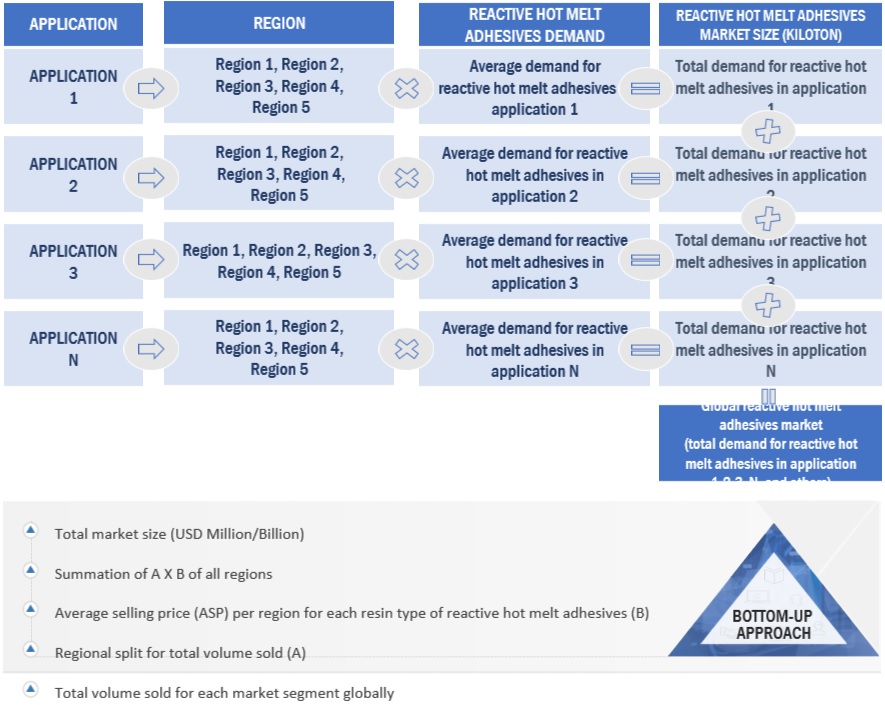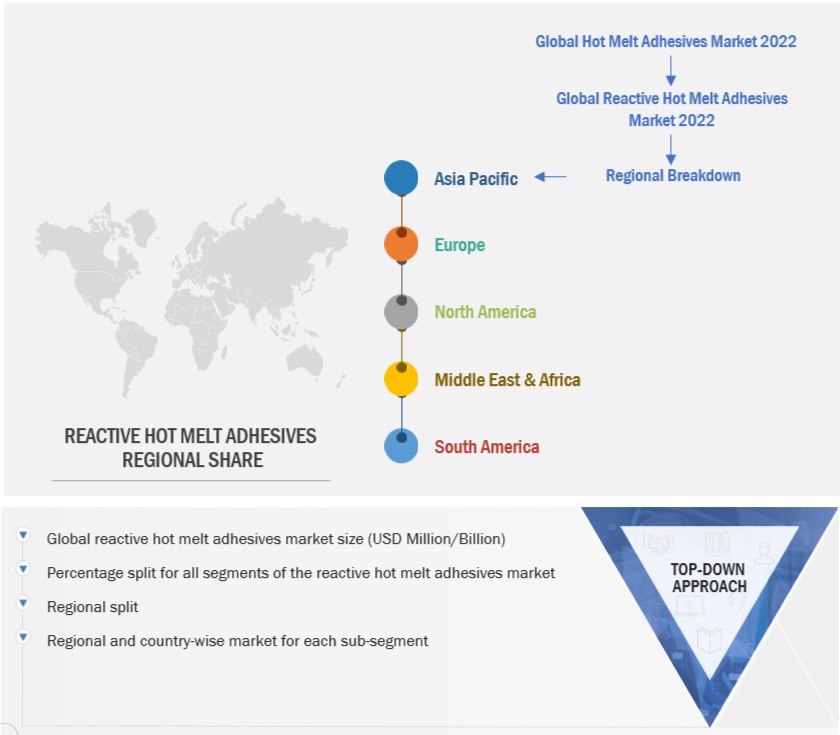This research study involves the use of extensive secondary sources, directories, and databases, such as Hoovers, Bloomberg L.P., Factiva, ICIS, and OneSource, to identify and collect information useful for this technical, market-oriented, and commercial study of the global reactive hot melt adhesives market. Primary sources are mainly industry experts from core and related industries, preferred suppliers, manufacturers, distributors, service providers, and organizations related to all segments of the value chain of this industry. In-depth interviews were conducted with various primary respondents, including key industry participants, subject matter experts (SMEs), C-level executives of key market players, and industry consultants, among other experts, to obtain and verify critical qualitative and quantitative information as well as assess growth prospects of the market.
Secondary Research
In the secondary research process, various secondary sources were referred to for identifying and collecting information for this study. These secondary sources include annual reports, press releases & investor presentations of companies, white papers, regulatory bodies, trade directories, certified publications, articles from recognized authors, gold and silver standard websites, and databases.
Secondary research has been used to obtain key information about the value chain of the industry, the total pool of key players, market classification & segmentation according to industry trends to the bottom-most level, and regional markets. It has also been used to obtain information about key developments from a market-oriented perspective.
Primary Research
In the primary research process, various sources from both, the supply and demand sides were interviewed to obtain and verify qualitative and quantitative information for this report as well as analyze prospects. Primary sources from the supply side include industry experts such as CEOs, vice presidents, marketing directors, technology and innovation directors, and related executives from various leading companies and organizations operating in the reactive hot melt adhesives market. Primary sources from the demand side include experts and key persons from the application segment. Extensive primary research has been conducted after understanding and analyzing the current scenario of the reactive hot melt adhesivess market through secondary research. Several primary interviews were conducted with market experts from both, the demand and supply sides across five major regions: North America, Europe, Asia Pacific, Middle East & Africa, and South America.
Following is the breakdown of primary respondents:

To know about the assumptions considered for the study, download the pdf brochure
Market Size Estimation
The top-down and bottom-up approaches have been used to estimate and validate the size of the reactive hot melt adhesives market on the basis of different end-use industries and types in each of the regions. The key players in the market have been identified through secondary research, and their market shares in the respective regions have been determined through primary and secondary research. All percentage shares, splits, and breakdowns have been determined using secondary sources and verified through primary sources. All possible parameters that can affect the market have been accounted for in this research study, viewed in extensive detail, verified through primary research, and analyzed to get the final quantitative and qualitative data.
Global Reactive Hot Melt Adhesives Market Size: Bottom Up Approach

To know about the assumptions considered for the study, Request for Free Sample Report
Global Reactive Hot Melt Adhesives Market Size: Top-down Approach

Data Triangulation
After arriving at the overall market size, the total market has been split into several segments. To complete the overall market engineering process and arrive at the exact statistics for all segments, the data triangulation and market breakdown procedures have been employed, wherever applicable. The data have been triangulated by studying various factors and trends from the demand and supply sides. Along with this, the market has been validated using both top-down and bottom-up approaches. Then, it has been verified through primary interviews. Hence, for every data segment, there are three sources, one from the top-down approach, second from the bottom-up approach, and third from expert interviews. Only when the values arrived at from the three points match, the data have been assumed correct.
Market Definition.
According to Adhesive and Sealant Council, reactive hot-melt adhesives are solid prepolymers terminated in reactive groups manufactured from mixtures of solid and liquid polyester/ether polyols with isocyanates, which are very low in free isocyanates. These solid prepolymers have a lower melting point than conventional hot-melt adhesives but show final strength and mechanical performance similar to a reactive system. Each of the raw materials can be appropriately adjusted to obtain required pot life, open time, and green strength.
Key Stakeholders
-
Reactive hot melt adhesive manufacturers
-
Raw material suppliers
-
Manufacturing technology providers
-
Industry associations
-
Stakeholders in the reactive hot melt industry
-
Traders, distributors, and suppliers of reactive hot melt adhesives
-
NGOs, government bodies, regional agencies, and research organizations
Report Objectives
-
To define, describe, and forecast the size of reactive hot melt adhesives market in terms of both value and volume
-
To provide detailed information about the key factors (drivers, restraints, opportunities, and challenges) influencing the growth of the market
-
To forecast the market size by resin type, type, substrate, and application
-
To forecast the market size with respect to five main regions: North America, Europe, Asia Pacific, the Middle East & Africa, and South America
-
To strategically analyze micromarkets1 with respect to individual growth trends, prospects, and their contribution to the overall market
-
To analyze opportunities in the market for stakeholders and provide a competitive landscape for market leaders
-
To analyze competitive developments in the market, such as new product development, acquisition, agreement, collaboration, partnership, expansion, and innovation
-
To strategically profile the key players and comprehensively analyze their market shares and core competencies2
Note: 1. Micromarkets are defined as the subsegments of the global reactive hot melt adhesives market included in the report.
2. Core competencies of companies are determined in terms of the key developments and strategies adopted by them to sustain in the market.
Available Customizations
MarketsandMarkets offers customizations according to the specific needs of the companies with the given market data.
The following customization options are available for the report:
Product Analysis
-
Product matrix, which gives a detailed comparison of the product portfolio of each company
Regional Analysis
-
Further breakdown of the reactive hot melt adhesives market, by country
Company Information
-
Detailed analysis and profiling of additional market players (up to five)



Growth opportunities and latent adjacency in Reactive Hot Melt Adhesives Market